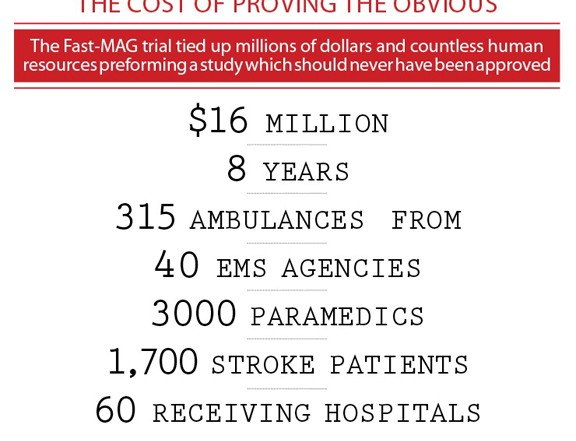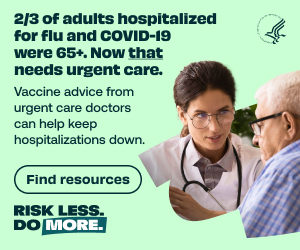The results are in. According to the Fast-Mag study, IV magnesium given for stroke patients in the field doesn’t do anything therapeutically. That’s what was reported at the recently completed meeting of the American Stroke Association.
The most expensive prehospital study in history should never have happened.
The results are in. According to the Fast-Mag study, IV magnesium given for stroke patients in the field doesn’t do anything therapeutically. That’s what was reported at the recently completed meeting of the American Stroke Association.
Surprise, surprise. In my humble opinion this study should have never been funded by the National Institute of Neurological Disorders and I want whatever portion of my very nasty annual income taxes that paid for this $16 million study (the most expensive prehospital study in history) returned – with interest.
Although there were some theoretical reasons why magnesium may improve outcomes in stroke, it just didn’t deliver in a very important study of hospitalized stroke patients – the IMAGES trial (see abstract below).
Published 10 years ago, this large trial (2,589 ischemic stroke patients) not only demonstrated that magnesium given within 12 hours did not improve death or disability at 90 days but a predefined subgroup analysis demonstrated that it also did not work in individuals treated within six hours of stroke onset. The six-hour analysis involved lots of patients – 440 placebo patients and 436 magnesium-treated patients.
What conclusion can be drawn from the IMAGES trial? Perhaps magnesium was not given at an aggressive enough dose or soon enough? We all are told that “time is brain” but this may, in actuality, be difficult to prove.
So, if you are still a believer in the potential of magnesium, why not try and give magnesium in a pilot clinical study involving stroke patients in the ED? It would have been a relatively simple study to do. It could have been performed in selected EDs throughout the country and the answer would have been established in a fraction of eight years and at a very small fraction of $16 million.
Instead, the Fast-Mag investigators decide that giving magnesium in the field (probably about 10-20 minutes faster than could be given in the ED) would be a reasonable study. And somehow these investigators were successful in convincing the NINDS folks that 10-20 minutes would matter – when it was never studied in the ED setting and proven not to work at 6 hours. Amazing.
Fast-Mag took 8 years and involved 315 ambulances based in 40 EMS agencies. Nearly three thousand paramedics took about 1,700 stroke patients to 60 receiving hospitals in Los Angeles county to prove what was already essentially known – that this drug doesn’t improve stroke outcomes.
And who knows what the real cost was for the Fast-Mag trial. How much time was spent in paramedic training? What about uncompensated time spent by hospital EPs and neurologist and others?
To salvage what they could of this disaster, the co-principal investigator, Dr. Jeffrey Saver of UCLA claimed that this study was a “game changer” in that it established that paramedics could give drugs to stroke patients in the field. He claimed that now that the infrastructure is in place, the search is on for new drugs and treatments that can be administered in the field to improve long-term outcomes.
Excuse me? Who has established that time is brain? Who has established that giving drugs in the field will have a better outcome than giving them in the ED? There are some massive assumptions here that need to be challenged before one more dollar is spent trying to demonstrate that prehospital administration of any drug will make a difference in stroke outcomes.
And, please, no – don’t even consider the idea of giving tPA in the field.
In a commentary regarding the IMAGES trial by Larry Goldstein of the Duke Center for Cerebrovascular Disease in the same issue of the Lancet in which the study was published, he noted that of more than 40 clinical trials of “neuroprotectants” involving over 11,000 patients, none has shown any evidence of benefit. Ten years later, the same is true.
Dr. Saver himself acknowledged what has long been known – that magnesium doesn’t cross the blood-brain barrier very well at all and that blood levels do not drive acute brain levels.
“We know magnesium penetrates the blood–brain barrier slowly,” he said in an interview. “But in an injured area of the brain, the blood–brain barrier breaks down to some extent and we thought that would increase the uptake.”
Perhaps some preliminary studies by the investigators looking at just what kind of brain levels could be expected might have been nice before dumping about $9,400 per patient into a study that, by all available evidence, was doomed to fail.

MAGNESIUM FOR ACUTE STROKE (INTRAVENOUS MAGNESIUM EFFICACY IN STROKE TRIAL) IMAGES
Study Investigators Lancet 363:439, February 7, 2004
BACKGROUND: Interventions purported to be beneficial for patients with acute stroke have had limited clinical applicability. There has been speculation that magnesium, which has properties that might theoretically be protective at the level of metabolic and neurochemical events occurring within the ischemic penumbra, could be beneficial.
METHODS: In this controlled, multicenter, international study, coordinated at the University of Glasgow, 2,598 adults presenting with a clinical diagnosis of stroke, within twelve hours after symptom onset, were randomized to treatment with IV magnesium (a 16mmol [4g] bolus given over 15 minutes, followed by 65mmol [16.15mg] given over 24 hours) or saline placebo.
RESULTS: There were no statistical differences between the groups in baseline characteristics or the median interval to treatment (about 7 hours). There were no intergroup differences in the rates of the primary outcomes of death (odds ratio [OR] in the magnesium group, 1.22) or disability (ORs 0.91-1.03 for various neurological outcome scores), or in global outcomes (OR 0.95). Findings were not influenced by the interval to treatment (less or more than six hours) or type of stroke (ischemic or non-ischemic), although a poor outcome appeared to be less likely withmagnesium treatment in patients with a non-cortical stroke syndrome (OR 0.75). There were no statistical differences between the groups in rates of early serious adverse events.
CONCLUSIONS: Despite theoretical speculation about possible benefit, early administration of IV magnesium did not improve outcomes in patients presenting with acute stroke. 30 references
Copyright 2004 by Emergency Medical Abstracts – All Rights Reserved 7/04 – #18
Richard Bukata, MD is Editor of Emergency Medical Abstracts (www.ccme.org)










4 Comments
Dear Dr. Bukata,
As an ED physician, board-certified internist, practicing attorney, and former director of an academic stroke education program, I agree with you 100%!!!
Now, what about the >> $1-2 TRILLION of your (and my!) tax dollars we are flushing down the toilet via the “UN-affordable care act”??
I admire your continued immunity to the “kool-aid” spewers – please tell me you have not been brainwashed by ACEP, the AMA, ACP, and others into believing that handing out Medicaid cards to millions will actually make healthcare (and ED care) better for our nation!
Thanks!!
Dear Dr Bukata,
Youve implied that the trial was both unnecessary on scientific merit and it should have been performed in the ED to sayave money. Can you clarify, would you have supported the same study being performed in the ED?
Also, Do you have any data to support the 10-20 minutes saved is negligible? What if 30-40 minutes were saved?
It obvious you have been “burnt” by a medic in the past, but why wouldnt you like to see, as a man of science, the effects of tPa study performed prehospital?
Please tell me your not arrogant prick you came across as…
Makes one wonder about the review process, who gets selected to participate (or not to be invited to participate) and whether there ever are any after action discussions about the decision making process.
Rick,
Totally agree with your take on this study. I wanted to follow up on something you mentioned at the end: “And please, no – don’t even consider the idea of giving tPA in the field”. Well, it’s already been done, and published in JAMA (JAMA. 2014;311(16):1622-1631). And just like the mag, it was a flop – didn’t save any lives. Apparently, neurologists will keep looking for the silver bullet. I pray I don’t fall into their hands when my time comes.
Aaron